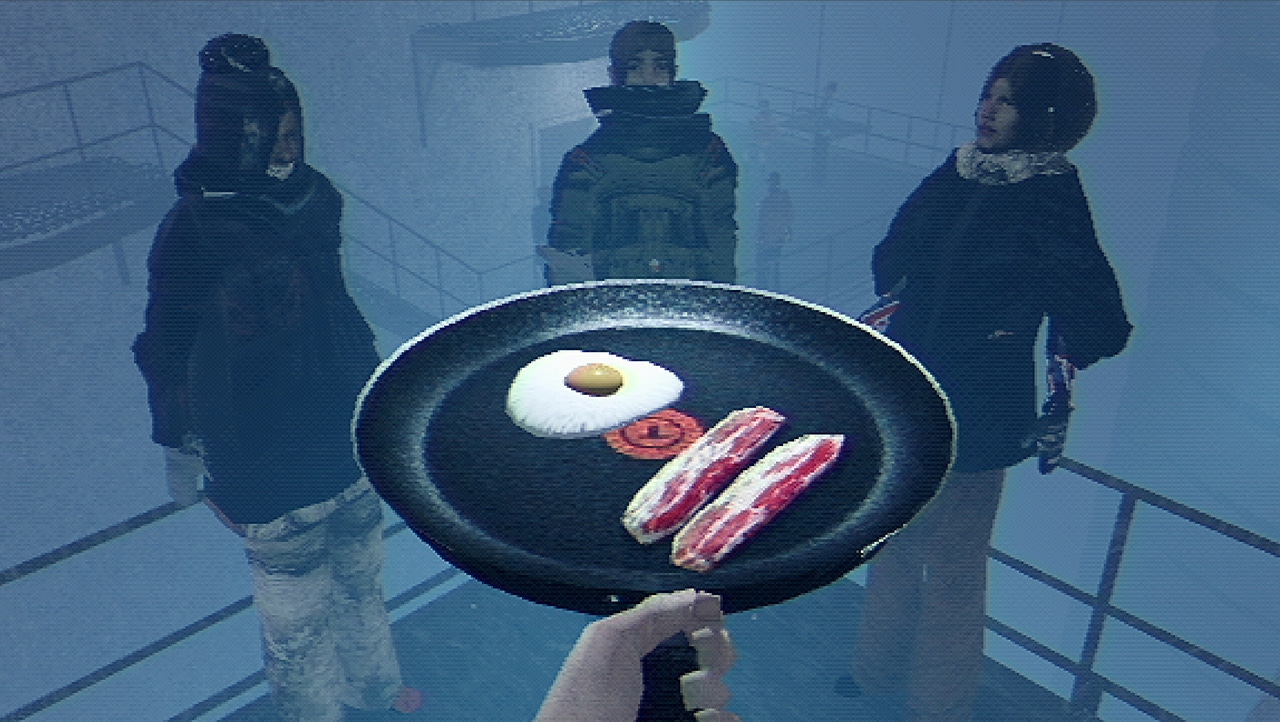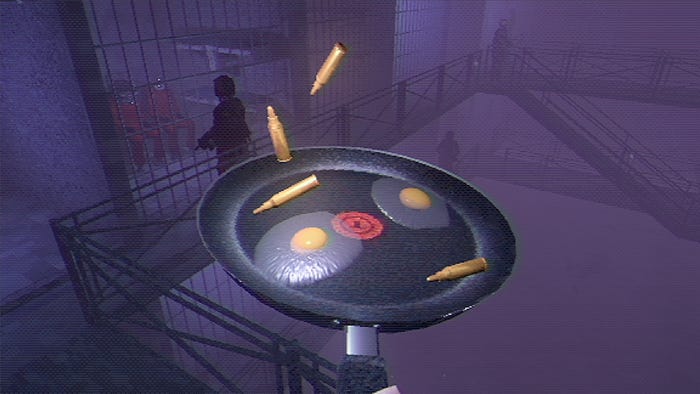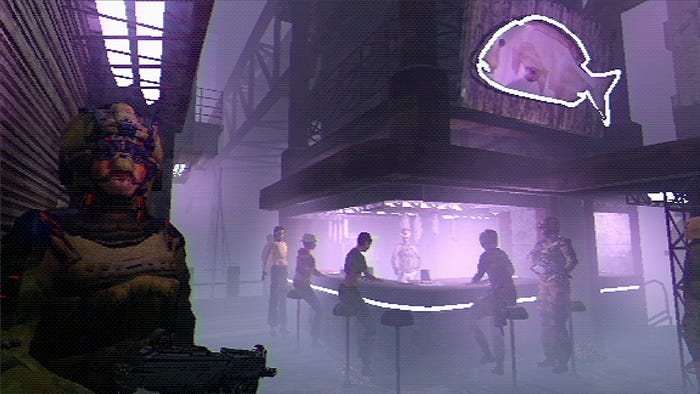Trending
Opinion: How will Project 2025 impact game developers?
The Heritage Foundation's manifesto for the possible next administration could do great harm to many, including large portions of the game development community.

| Dig in! Exploring Cooking Mechanics in Games | ||
| Every day this week, Game Developer is serving up a feast of interviews, deep dives, and more digging into the evolution of Cooking in video games. | ||
| Browse Latest Articles | Submit your Blog | |
Developer Keven Brown tells us why he chose a chilly, bleak setting for a game about the social experience of eating.

Arctic Eggs takes the player to a gray, frozen Antarctic settlement, having them fry up eggs, bacon, and other odd eats for the people eking out a living in such a frigid place.
Game Developer caught up with Keven Brown of The Water Museum, creators of this chilly cooking experience, to talk about the strange origins of creating a game about frying eggs in a depressing sci-fi future, the deep thoughts that went into making the frying mechanic work just right, and how the limitations of a game jam would lead to creating just the perfect bleak world for players to cook in.
Game Developer: Arctic Eggs is a “sci-fi cooking game” about a poultry peddler feeding lonely folks in the Arctic. What inspired the creation of this game? Why explore egg frying in a chilly future?
Keven Brown: So frying eggs in the future was definitely not what I initially set out to do. Arctic Eggs began as a much larger and more complex project. The initial idea was that you are actually a fast-food worker working night shifts, hoping to save up enough money for a plane ticket to Antarctica. It was meant to feature tons of cooking activities and ingredients, but after months and months of work, nothing really felt fun in a meaningful way except for just flipping eggs around in a pan. At the time, I really didn't believe I could make a full game with just that one mechanic, so I moved on.
Later, as I was knee-deep in another project, I played Tales From Off-Peak City, a game where all you do is make pizzas, talk to people, and explore the world. It is deceptively simple and I loved it. I figured once I was done with this bigger project I would try to make something like this with the frying pan mechanic I made prior. As luck would have it, shortly afterward, Youtuber Dunkey announced he was hosting a two-week-long game jam, and I figured this would be a quick way to get this idea out of my system.
The futuristic part of the game wasn't well thought out at first. While working on another project called Ettare, I met CDbunker2. He is not only a skilled 3D artist but also an incredibly fast worker. Because of this, I knew if I wanted to make something really interesting I needed his help on the project. I doubted I would be able to convince him to abandon Ettare for a few weeks to help out on a random cooking game. So, in order to maybe create a bit more intrigue around the idea, I decided to just tack on some sort of sci-fi twist to the whole thing. Thankfully, this was just enough to spark his interest and get him excited about the entire prospect. And just as I hoped, bringing him on board transformed the game into something special and unique. It became as much about storytelling as it was about cooking.
Can you tell us the thoughts that went into the game's complex frying system and tying that action to mouse movements?
So, the frying itself is extremely simple. You move your mouse, and it tilts the pan, and you need to keep the pan moving to generate heat. I had to fight really hard with myself to keep it that way throughout development because I think that's where the success of the game comes from. The lack of options allows anyone, in less than a few seconds, to be completely ready for any challenge I throw at you, allowing the actual levels to be pretty open in how you decide to navigate them.
Also, this lack of complexity in the frying pan forces you to pay much more attention to the food itself. The shape and positioning are incredibly important, and throughout the game, you learn what each food is capable of and how best to maneuver it. Because of this, though, that means that the challenge of the game is completely dependent on you, because there are no tricks/upgrades/stats to make the game easier. It's all about your understanding of the frying pan and what you have to do to best maneuver what's inside it.
What challenges went into making this control scheme feel comfortable and getting the motion of flipping eggs and other foods to feel somewhat intuitive?
So, the biggest challenge, as I mentioned before, was sticking to the incredibly simple control scheme because moving the mouse to tilt the pan was, thankfully, a very intuitive process right from the start, and I was worried I would mess that up if I kept adding to it.
In the jam version of the game, you will notice some features that were present that got removed in the final version that's releasing soon. A big one was the ability to use WASD to move the pan around a little bit. My thinking was that if you flipped something poorly, you would get the chance to try to catch the falling food by adjusting your pan’s position. Granted, this did work for the most part; however (and you can see even see this in Dunkey’s stream of the game), players would mistakenly think that WASD was more important than mouse movement, leading to some extreme frustration early on, where they would just be mashing WASD hoping that the egg would hit the edge of the pan just right and with enough momentum to flip it over.
This, and one or two other pan abilities, just kind of muddied the waters, in my opinion. It was like I was telling players that there is a way to circumnavigate learning the ins and outs of the pan/physics when, in reality, there is not, and any time spent trying something different is time wasted in my eyes.

Images via The Water Museum.
What thoughts went into creating the different (sometimes odd) cooking requests the characters will ask the player? How did you design these around challenging the player with your cooking systems?
When coming up with new ingredients for Arctic Eggs, it always began with the question of, “How can I add a new challenge that gets in the way of egg flipping?” and then thinking of a food item or object that would justify that challenge.
One of the most basic challenges in most other cooking games is “don’t burn the food” and that was the first challenge I tried for Arctic Eggs as well. That is pretty easy to add—the part that really matters, though, is how this is communicated to the player. The video game-y thing to do would be to make some sort of UI element that indicates a food's health. I attempted this, but I hated everything I tried. It felt like it was no longer the frying pan and I taking on this world; it was me, the frying pan, and this out-of-place little UI hovering above the food babying me. That is when the cigarette ingredient was born. It provided a unique and UI-free method to indicate the remaining time via how much of the cigarette is left. And since I made this so early on in development (I think it was the first thing I made after the eggs), it really set the tone for the rest of the game. I decided any additional ingredient I make should make sense visually with the challenge at hand without any UI.
“I want an ingredient that you have to be more careful with.” Okay… Maybe a beer that you don't want tipping over and spilling everywhere? “I want an ingredient that you have to fight to keep in the pan.” Maybe a cockroach that scurries to the edge and tries to jump out? “I want an ingredient that you have to toss OUT of the pan.” Maybe a bullet that explodes if it gets too hot?
There were so many non-food related ideas I had that were built on top of the egg-flipping foundation, and since the cigarette itself is introduced so early on in the game I think players are very willing to accept it as a valid request in this world.
What thoughts went into the design of this grim Antarctic settlement? What feelings did you want the environments to evoke as the player wandered through here and fed people?
So, to get myself in a sci-fi headspace, I watched a ton of Cowboy Bebop (fantastic anime if you have never watched it) during the game jam, and I remember feeling a bit stuck on what the city should feel like near the beginning. Frustrated, I just decided to watch the show with my full attention instead of just having it off to the side. The Jupiter Jazz episodes just happened to be playing at the time. The city in those specific episodes is very cold and sparse, but because of how isolating it is, it feels as lifeless as a desert. The people there are all pretty indifferent towards their situation and each other. They aren't really sad; it just seems like the only glint of happiness they feel is when they are just hanging out together in the bar, listening to some guy play his saxophone. After watching these episodes, I remember thinking how perfectly that aligned with what I wanted to do.
The somewhat depressing brutalist aesthetic of the outer city was definitely born just out of necessity for the game jam. I didn't really think too much of it at the time. It is relatively easy to achieve a convincing brutalist city look with a couple of cement textures and some windowed rectangles. The city in the Jupiter Jazz episodes did have a ton of detail to them—ads hung up everywhere, pipes wrapping around other pipes—but with less than a week to finish everything, that type of busy look would have taken too long.
However, what’s interesting is what happened after the jam. I tried going back and sprucing things up, making things more “interesting,” but anything I tried just felt dishonest to the world. You are in Antarctica, the people are cold, hungry, and smoking cigarettes constantly. Something is clearly wrong here and making the environments more suited for people didn't feel right. The people barely belong here. I think the harshness of the environment is what really motivates players as well. Ultimately, you, as the player in the world, are inconsequential. You aren't trying to be a hero or kill the bad guy. You are just feeding people. I think that almost feels more important than saving the day when in contrast with the environment. Like you are just trying to be a tiny little moment of warmth for individuals in this cold, uninviting city.

Likewise, what ideas went into the designs of the characters players would be cooking for?
The initial idea for Arctic Eggs involved people at a rooftop party in a future Antarctic city. They needed cold-weather clothes but still looked like they'd come to have a good time. Above all else, I wanted them to be a little bit strange and off-putting on first impression to justify the weird stuff they ingest throughout the game.
CDbunker2 handled most of the character modeling in the game, and he writes this about their design/look: “The characters owe a heavy debt to fashion designers like Walter Van Beirendonck as well as comic books like Transmetropolitan and the hyper-detailed background characters in the works of Geoff Darrow. The nose tubes, cyborg parts, and random details are all attempts to suggest a typical cyberpunk future where people take part in extreme fads with drugs and body modification.
As the game developed its own feel, I tried to make the characters suggest a disaffected, disassociated sort of mood. They're contemplative, maybe bored, and always waiting to be fed, entertained, or to smoke another cigarette. Also, most importantly, as a designer, they had to look interesting. The players should want to come up to them. Even the menacing soldiers.”
What drew you to explore storytelling through food and cooking for people? How did you weave frying eggs into the stories that people tell you as you cook for them in Arctic Eggs?
Storytelling is one of the main things I wanted to explore with the game. Cooking in video games has been represented in many different ways already, whether it is used to demonstrate the technical intricacies of the culinary arts, explore a certain culture, or even just as a low-stakes break from a game’s main focus. But, in my opinion, the social aspect of cooking/eating has been kind of put on the back burner in most cooking games.
Cooking or eating makes for an incredibly welcoming setting when trying to tell a story because functionally when eating or cooking in a group setting, you are meant to just sit for a long period of time and mingle. As an inexperienced writer, I find it hard to tell a complex story naturally because I never want to come across as preachy, especially when it comes to lore. In real life, when was the last time you got a huge exposition dump about the history of our world from someone you just met? Or even someone you have known for awhile? I rarely do. In games, whenever this happens, I find myself skipping the dialogue. I feel like it's easy to see that it's not a real world I am learning about, it's just a writer going “Look at me! I am writing something interesting! Look!”
Rarely in Arctic Eggs does someone say anything outwardly important to you because these are strangers who don't really know you. This created an atmosphere that I think a lot of people found refreshing in the game. This is a setting where people are eating, so mingling with them feels natural—there is a story, but you genuinely don't have to engage with it if you don't want to because these characters have far more to say about mundane things they deal with every day.
The game is like being at a cookout, I think. The food is definitely the main selling point but it's really all just an excuse to get a big group together and socialize.
What interested you about exploring human connection and condition in a bleak future through cooking for people? What is it about cooking and eating that can help weave unique shared connections between people all over the world, and how did you want to use those feelings in Arctic Eggs?
I think many cooking games do a fantastic job at exploring human connection through cooking. Venba and Nainai’s Recipe come to mind. Both are incredibly beautiful games about culture, heritage, and reconnecting with something or someone through the act of making food. Cooking is a uniquely human ritual where we are expected to slow down and mingle, so it is unsurprising that so many cooking games are able to tell incredibly personal and emotional stories.
Arctic Eggs is also about connecting with others, but I think what sets it apart is the emphasis is taken off of the food itself. Most of the food in Arctic Eggs is kinda gross and unappetizing. The ingredients used are also repeated throughout at varying quantities, so it's hard to really make a connection with it. Because of this, though, the emphasis is on what the character says before you feed them (and sometimes after). This stranger who you would have probably walked right by (if you weren't specifically looking for another mouth to feed) has a life and you get a glimpse at what they care/worry about.
In Arctic Eggs, the food might not be appealing, but it's the vehicle that brings players into these unique exchanges with people you would have never connected with otherwise. Each interaction adds a layer to the story, making the mundane act of feeding someone a profound experience of connection and understanding.
You May Also Like